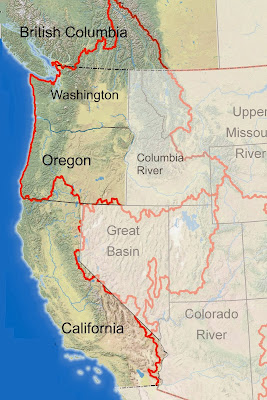And whither we go...where does California stand now that the The Fifth Assessment Report (AR5) is
being released by the IPCC? California's
climate change portal links to a very brief
summary of the initial findings in the IPCC report for policymakers, which states, among other things, that human influence on the climate system is clear. This is evident from the increasing greenhouse gas concentrations in the atmosphere, positive radiative forcing, observed warming, and understanding of the climate system.
The solution is also embedded in the IPCC report:
"Continued emissions of greenhouse gases will cause further warming and changes in all components of the climate system. Limiting climate change will require substantial and sustained reductions of greenhouse gas emissions...Cumulative emissions of CO2 largely determine global mean surface warming by the late 21st century and beyond. Most aspects of climate change will persist for many centuries even if emissions of CO2 are stopped. This represents a substantial multi-century climate change commitment created by past, present and future emissions of CO2".
Essentially that means that a WWII-style, massive mobilization of capital and efforts to cut carbon emissions will need to come into play, most likely with the kind of rationing that went into that war effort. Which is appropriate, considering that the country's - and the planet's - survival will depend upon unequivocal action. But, as in WWII, once this huge effort plays out, there's a probability that the science of addressing carbon emissions will come into full bloom, with the accompanying prosperity resulting in a planetary future that's sustainable and regenerative. It won't be about physical growth, but about a directed miniaturization that comes from new technologies and fewer demands on the environment.
California's Climate Change Portal emphasizes that local governments have important roles to play in these efforts to reduce greenhouse gas emissions, and they are at the forefront of efforts to adapt to the ongoing and anticipated impacts of climate change.This becomes the basis for action in policy and regulation in the state. The interesting part of this picture is that there's no Federal policy to base this upon, because it remains, as always, silent on climate change, with the exception of
position statements from the Obama Administration.
California's
Office of Planning and Research cites the IPCC findings and has issued a discussion draft, called "California at 50 Million, The Governor's Environmental Goals and Policy Report" for public review.The report considers the state’s future in the context of a changing climate and a population that is projected to grow to 50 million residents by middle of this century.
The goals in this document are linked to a set of indicators that will help track progress toward meeting long-term environmental goals.
It opens with this statement:
“By the time today’s children reach middle age, itis extremely likely that Earth’s life-support systems, critical for human prosperity and existence will be irretrievably damaged by the magnitude, global extent, and combination of these human-caused environmental stressors, unless we take concrete, immediate actions to ensure a sustainable, high-quality future.”
-
Scientists’ Consensus on Maintaining Humanity’s Life Support Systems for the 21st Century, May 2013
It goes on to say that it also considers growth in the context of climate change – "undoubtedly the biggest environmental challenge of our time" - in a very broad-brush policy document. Climate change and the state’s efforts to confront it will involve nearly every aspect of the state’s planning and investment for the future, and that the state will address these issues:
Meet AB 32 Emission Reduction Target
Reduce GHG Emissions 80% Below 1990 Levels by 2050
(note that this is not sufficient to meet climate change targets in the IPCC report)
Establish a Mid-Term Emission Reduction Target
Invest in Climate Readiness and Adaptation to Safeguard California
It also briefly outlines methods to decarbonize Energy and Transportation, and then goes on to address the importance of preserving natural lands and resources. It very briefly mentions a key, issue, water, along with a statement about the
Bay Delta Plan.
Among California's other efforts, there have been many emergent strategies to grapple with the scope of this problem,
summarized in this article. Essentially where California stands at the moment is an attempt to grasp the enormity of the problem and begin the hard work of realizing what it will actually take to deal with it. Of a scope and
scale never seen before on this earth.



























